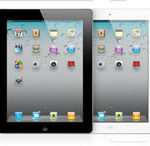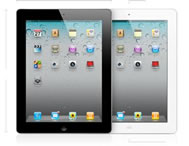
Apple is back with a second-generation tablet computer that squeezes more power into a thinner shell while keeping prices in check. Underscoring the tablet’s importance to Apple, CEO Steve Jobs briefly emerged from a medical leave on March 2 and made a surprising appearance to unveil the iPad 2 himself.
With the original iPad, Apple proved there is great demand for a tablet that’s less than a laptop and more than a smart phone, yet performs many of the same tasks.
Dozens of copycat touch-screen devices are in the works, but so far none has broken into the mainstream consciousness the way the iPad has.
“The competition is essentially going to be picking up the crumbs that Apple decides to leave behind,” said Ashok Kumar, an analyst with Rodman & Renshaw.
He said the number of software applications—or “apps”—available for the iPad gives Apple a huge advantage.
Sarah Rotman Epps, a Forrester Research analyst, said iPads should make up at least 20 million of the 24.1 million tablet computers she expects people in the U.S. to buy this year.
Except for Jobs’ appearance, little about the iPad 2 came as a surprise after months of speculation about features and upgrades. The tablet has two cameras built in for taking photos, recording video, and video chatting. The battery life will be the same as the original—about 10 hours of usage or a month on standby.
The iPad 2 is faster than its predecessor. Ross Rubin, an analyst for the market researchers NPD Group, said that should make the iPad better for creating music, video, and other content, rather than just consuming it.
The iPad 2 is also thinner—8.8 millimeters, or about a third of an inch, instead of the current 13.4 millimeters. It weighs just a bit less—1.3 pounds, compared with the original 1.5 pounds.
With a $39 accessory, people can connect the tablet to televisions, so they can watch high-definition videos on the bigger screen.
The next-generation iPads will cost the same as the originals—$499 to $829, depending on storage space and whether they can connect to the internet over a cellular network. Apple will add a white model to the current black. In the U.S., the iPad 2 will go on sale March 11 and work on AT&T Inc. and Verizon Wireless.
Apple’s online store began selling the original models for $100 off, starting at $399. Refurbished versions were even lower, starting at $349.
A reporter who used a white iPad 2 immediately after the announcement found it noticeably thinner, with a more rounded back. YouTube video loaded quickly using AT&T’s data service, and “Toy Story 3” played smoothly.
Given its size, the iPad 2 appeared impractical for taking lots of photos, but both cameras will help with video chats—the front one to show the caller, and the back one to show what the caller is seeing.
The iPad 2 shared the spotlight with the man who presented it—Jobs, who announced in January that he would take a third leave of absence to focus on his health. In the last decade, Jobs, 56, has survived a rare but curable form of pancreatic cancer and undergone a liver transplant.
Jobs, looking frail in his signature black mock turtleneck and blue jeans, was greeted with a standing ovation.
“We’ve been working on this product for a while, and I just didn’t want to miss today,” Jobs told an audience that included bloggers and Apple enthusiasts. “Thank you for having me.”
He did not address his health or say if and when he would return.
Tablet computers existed long before the iPad, but it took Apple to build a device that made sense to consumers. Apple simplified the software, designed a sleek, shiny shell, and sold 15 million of the iPads in nine months.
Competitors, including Dell Inc. and Samsung Electronics Co., have been trying since last year to lure consumers with smaller tablets, without much success.
In February, Motorola Mobility Inc.’s Xoom went on sale with a new version of Google Inc.’s Android software that was designed for tablets, not smart phones.
For a moment, the Xoom looks promising, with a comparably sized screen, a faster processor, and a few other bells and whistles the original iPad didn’t have. But the iPad 2 catches up again with dual cameras and a faster chip inside. It pulls ahead with a slimmer profile and the ever-expanding number of tablet-specific apps.
After its March 11 U.S. launch, the iPad 2 goes on sale March 25 in 26 other markets, including Mexico, New Zealand, Spain, and other European countries.
Apple also introduced updates to the software that runs on the iPad, iPhone, and iPod Touch. The company said the update, iOS 4.3, will work on iPhone 3GS and iPhone 4 models, except the new version for Verizon Wireless.
Among other things, the new system turns iPhones and iPads with 3G cellular connections into personal Wi-Fi hotspots, so you can share the connection with computers or other devices—if your wireless carrier allows it. Many charge additional fees for this service.
Apple also announced new software designed for the iPad, including a $4.99 version of iMovie for video editing and a $4.99 version of GarageBand, its music recording and editing software. GarageBand includes instruments that can be played by touching the iPad 2’s screen, and it can even sense whether you’re tapping quietly or banging on the “keys.”
The company also said Random House became the last major publisher to agree to sell its titles in Apple’s eBooks store.
- Extron AV Switching, Streaming, and Control Systems Aid Higher Learning at Idaho’s First Medical School - June 1, 2021
- Extron XTP, Streaming, and Control Systems Empower Point Park University’s Varsity Esports Program - June 1, 2021
- Extron NAV Series Delivers AVoIP Throughout Allied Health Veterans Hall at UNC Wilmington - June 1, 2021

